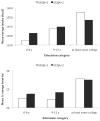Acculturation and dietary change among Chinese immigrant women in the United States
- PMID: 25281323
- PMCID: PMC4370775
- DOI: 10.1007/s10903-014-0118-4
Acculturation and dietary change among Chinese immigrant women in the United States
Abstract
US Chinese immigrants undergo a transition to increased chronic disease risk commonly attributed to acculturative and dietary changes. Longitudinal data to confirm this are lacking. We examined acculturation and diet over time in 312 Chinese immigrant women in Philadelphia, recruited October 2005 to April 2008 and followed with interviews and dietary recalls until April 2010. Associations were modeled using generalized estimating equations to account for repeated measures over time. Increasing length of US residence was associated with a small (~1%/year) but significant increase in acculturation score (p < 0.0001), which in turn was significantly associated with increased energy density of the diet, percent of energy from fat, and sugar intake, and lower dietary moderation score. These findings provide longitudinal evidence that acculturation increases with length of US residence and is accompanied by dietary changes. However, the changes were small enough that their health impact is unclear. Factors besides acculturation that affect immigrant health and that affect the acculturation trajectory itself warrant investigation.
Figures


Similar articles
-
Acculturation and Insulin Resistance among US Chinese Immigrant Women.Ethn Dis. 2015 Nov 5;25(4):443-50. doi: 10.18865/ed.25.4.443. Ethn Dis. 2015. PMID: 26672487 Free PMC article.
-
Acculturative stress and inflammation among Chinese immigrant women.Psychosom Med. 2014 Jun;76(5):320-6. doi: 10.1097/PSY.0000000000000065. Psychosom Med. 2014. PMID: 24846001 Free PMC article.
-
Improved dietary variety and adequacy but lower dietary moderation with acculturation in Chinese women in the United States.J Am Diet Assoc. 2010 Mar;110(3):457-62. doi: 10.1016/j.jada.2009.11.016. J Am Diet Assoc. 2010. PMID: 20184998 Free PMC article.
-
[What is the diet of the immigrant population resident in Spain? Results based on a systematic review].An Sist Sanit Navar. 2019 Apr 25;42(1):55-68. doi: 10.23938/ASSN.0389. An Sist Sanit Navar. 2019. PMID: 30706902 Spanish.
-
Dietary intake and habits of South Asian immigrants living in Western countries.Nutr Rev. 2017 Jun 1;75(6):391-404. doi: 10.1093/nutrit/nux023. Nutr Rev. 2017. PMID: 28591786 Free PMC article. Review.
Cited by
-
Trends in Diet Quality by Race/Ethnicity among Adults in the United States for 2011-2018.Nutrients. 2022 Oct 8;14(19):4178. doi: 10.3390/nu14194178. Nutrients. 2022. PMID: 36235830 Free PMC article.
-
Exploring the Determinants of Food Choice in Chinese Mainlanders and Chinese Immigrants: A Systematic Review.Nutrients. 2022 Jan 14;14(2):346. doi: 10.3390/nu14020346. Nutrients. 2022. PMID: 35057524 Free PMC article.
-
Health Risk Behaviours by Immigrants' Duration of Residence: A Systematic Review and Meta-Analysis.Int J Public Health. 2022 Aug 5;67:1604437. doi: 10.3389/ijph.2022.1604437. eCollection 2022. Int J Public Health. 2022. PMID: 35990194 Free PMC article.
-
Cultural Factors relevant to Korean Americans in Health Research: A Systematic Review.J Community Health. 2018 Apr;43(2):421-432. doi: 10.1007/s10900-017-0418-4. J Community Health. 2018. PMID: 28905156
-
Bi-dimensional acculturation and depressive symptom trajectories from pregnancy to 1 year postpartum in marriage-based immigrant women in Taiwan.Psychol Med. 2022 Sep;52(12):2290-2298. doi: 10.1017/S0033291720004195. Epub 2020 Dec 2. Psychol Med. 2022. PMID: 33261673 Free PMC article.
References
-
- Goel MS, McCarthy EP, Phillips RS, Wee CC. Obesity among US immigrant subgroups by duration of residence. JAMA. 2004;292:2860–7. - PubMed
-
- Ziegler RG, Hoover RN, Pike MC, Hildesheim A, Nomura AM, West DW, et al. Migration patterns and breast cancer risk in Asian-American women. J Natl Cancer Inst. 1993;85:1819–27. - PubMed
-
- Stanford JL, Herrinton LJ, Schwartz SM, Weiss NS. Breast cancer incidence in Asian migrants to the United States and their descendants. Epidemiology. 1995;6:181–3. - PubMed
-
- Cook LS, Goldoft M, Schwartz SM, Weiss NS. Incidence of adenocarcinoma of the prostate in Asian immigrants to the United States and their descendants. J Urol. 1999;161:152–5. - PubMed
-
- Huh J, Prause JA, Dooley CD. The impact of nativity on chronic diseases, self-rated health and comorbidity status of Asian and Hispanic immigrants. J Immigr Minor Health. 2008;10:103–18. - PubMed
Publication types
MeSH terms
Grants and funding
LinkOut - more resources
Full Text Sources
Other Literature Sources
Miscellaneous

